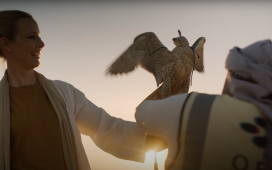
The Mobile Marketing Association is set to launch in the Middle East. Iain Akerman caught up with EMEA managing director Chris Babayode to find out how it plans to help marketers make the most of mobile
Chris Babayode and I are sitting in a private member’s club in London just off Tottenham Court Road. It’s not because we’re posh or anything, but because Babayode doesn’t have an office.
As befits the managing director for Europe, the Middle East and Africa at the Mobile Marking Association (MMA), Babayode is himself mobile. So much so that the only office the global non-profit organisation owns is in New York.
“We don’t really do physical offices, as you can see,” he says with a laugh, before ordering us both coffee and explaining the reason for us being here.
Within the next few months the MMA will launch in the Middle East, bringing with it its mission of accelerating the transformation of marketing through mobile. So far six founders are onboard – all based in the United Arab Emirates – with the names of those companies and agencies to be revealed at the MMA’s official launch. They will be responsible for electing a board that will “deliver events and activities in the region that will help effectively build the knowledge, capability, and confidence of marketers involved in mobile marketing”.
“That’s really the goal,” says Babayode. “And it’s really an education programme that aligns with what we do globally, regionally and locally.
“Part of the challenge of mobile marketing is this: the usage, the penetration and the numbers – and I don’t just mean for phones but also for tablets and the viewing of video through mobile devices – are so high in the Middle East region, yet the advertising dollars are not following the eyeballs and the fingers and thumbs. And one of the reasons for this is that if you’re not knowledgeable or confident about what is best for your brand and how mobile best works, you’re never going to really engage with it to the level that you are if you have a level of confidence and understanding of TV or outdoor.
“So our job is to build that confidence, build that engagement, build that understanding, deliver the best cases and best practices from outside the region, as well as build individual cases and best practices on the ground. If you raise everybody’s confidence and knowledge and understanding then I think advertising expenditure will grow on mobile, and because mobile can deliver very effective ROI for marketers, their business will grow as well.”
In a bid to achieve this the MMA will not only be utilising seminars, conferences and reports, but will be focussing on proprietary research, creative innovation and attribution analysis.
It is easy, though, to understand why the association is launching in the region. Mobile penetration rates are through the roof within the Gulf, while Saudi Arabia is the world’s biggest consumer of YouTube videos, largely through mobile.
“One of the challenges we hear is ‘I know mobile’s in everybody’s hand, but how do I engage with the consumer? What’s the creative ad units? What should I do? What’s best for me? So we’ve got a framework around building best creative practices on mobile,” says Babayode. “Also, how can we measure mobile’s effectiveness in a way that will allow marketers to go to their chief financial officer or chief executive and say ‘my budget needs to be greater because I know this is the effect. This is what we will get back as a business’.”
Within the proprietary research, case studies feature heavily, although most are a member benefit and not available to all. Still, campaigns by the likes of Coca-Cola, MasterCard and AT&T have been dissected, with the association set to launch more by the likes of Unilever in the near future.
Although the Middle East chapter will be based in Dubai, Babayode is keen to make sure “we’re representative of the region”, while the goal is to attract between 20 and 25 member companies by the end of the first year of operation.
How will the association get people to listen? Largely through the advocacy of its members and the insights it plans to offer.
“Creative works really well on mobile devices if you have multiple creative [executions] shown at low frequency,” says Babayode. “Budgets not withstanding, if you have three or four different creative [executions] for the type of message or offer you’re promoting – and you can show those pieces of creative to a user two or three times rather than one piece of creative 10 times – the return you get is greatly improved.”
He adds: “There are so many great opportunities within mobile marketing, whether it’s location targeting, whether it’s the best use of programmatic, whether it’s mobile video and different display formats, that actually trying to cut through the clutter and work out what’s best for your brand becomes difficult.
“So we’re here to sort of, I call it ‘ease the friction’, although I don’t mean as in confrontational, but as in smooth the path so that agencies and marketers and vendors are all pushing towards the same objective. If there’s an industry independent body that raises the level of capability, then within that companies fight for their share. But the larger the cake the larger the slice for all.”









